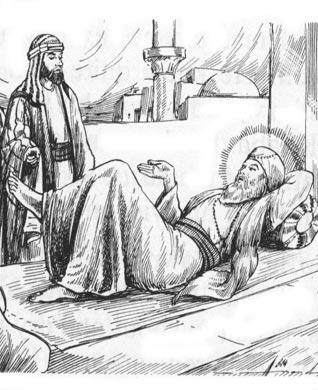Kids' Corner
God is Everywhere
Living Sikhi - Lesson Twenty Seven
by VERONICA SIDHU
GOD IS EVERYWHERE
Lesson Objectives:
1 To appreciate how fearless Guru Nanak was.
2 To appreciate how gentle Guru Nanak was in teaching his message of pure truth.
3 To begin to understand why we cannot see God, like we see other people.
Teachers, ask the students to say the Sikh greeting with you; then fold hands and do simran with the students.
Homework Review:
Ask for volunteers to read their interpretation of Guru Nanak's startling wish: That all the people should have to leave the village of kindness and that all the people from the village of unkindness should stay where they were. Ask if any of the students can apply this lesson to their own lives. (You may have to prompt them: Wherever we go, no matter how far from home, we can always be a good example to others by our kindness by observing the golden rule of "vund chhukna".)
Read pages 87-92. Teachers, please show the students a map or globe so that they have some concrete idea of where Mecca is in relation to Punjab. Also, please correct the error in the book. The Kaaba is not a mosque, but is a sacred black stone, outdoors, which Muslim pilgrims circle while on the Haj. Show a photo of pilgrims on the Haj.
Guru Nanak, you'll remember, had traveled as far east as China and as far south as Sri Lanka. He had met many people who were deeply spiritual and with great wisdom, and also many people who had become stuck in cultural practices like rituals and observances that they believed would bring them closer to God, but were paths that lead nowhere. Guru Nanak brought to all a simple message - the three Golden Rules: Naam Juppna, remember the One God. Vund Chkukna, help others and Kirat Karni, do honest work.It was a good thing that by the time Guru Nanak traveled to Mecca, he had lots of practice in staying calm and focused on the Realm of Truth, Such Khund. Why? (Pause for answers.) Right! There were thousands of pilgrims on the haj with him. Most had waited all their lives to go on this special pilgrimage. Most were in a very high emotional state of devotion. Most would be very, very angry if they thought that someone was disrespecting the holy place. And, yes, they were very angry when they saw Guru Nanak was resting with his feet pointing toward the Kaaba, the sacred black stone. One young man even began kicking Guru Nanak awake.
Guru Nanak must have been in such a trance of bliss, with no fear whatsoever on his face even in the midst of all the shouting, that people somehow became as curious as they were upset. Because of Guru Nanak's calmness and heart of compassion, they somehow were able to listen to his request: "O then, please point my feet to where God does not live!"
If people think that God is in a stone or an idol or lives in a certain place but not in another place, how do they behave? Yes, they respect some places or things more than they respect others or the people who may live there. They also think that these things or places are more important than behaving in a kind and respectful way toward all people in all places. This can lead to terrible misunderstandings, cruelty against others, conflicts, and even wars. What Guru Nanak was teaching, not just to the people in Mecca, but to all of us, is that God is One, everywhere, and that the God-world can be reached by everyone.
Guru Nanak taught us that God cannot be contained in a stone, or a place of worship, or even in an entire country. There are no people more dear to God than other people are. God is a formless spirit that pervades the whole universe. This is why, when people ask, why can't we see God, we can say truly say, "Yes, we can see God in this way!"
God is not a person, but yet all people and everything in the universe are part of God, from the farthest star to the smallest atom, the greatest king or the poorest beggar. God's light is in everyone. This is why we have respect for all. We do not have to leave our homes to find God. We do not have to worry. God is in our hearts.
Guru Nanak wrote the beautiful Aarti hymn which we find in Kirtan Sohila, the bedtime prayer. Aarti means "worship" and in India, in Hindu temples, the idols of gods and goddeses were - and still are - worshiped in a ceremony in which the priest holds a tray or platter. On it would be offerings of fruit or flowers. Small, sometimes jewel-encrusted lamps filled with clarified butter are lit and incense is burned for its lovely scent.
But in Guru Nanak's version of aarti, he tells us that true worship is performed by all of creation - if we open our eyes to truly understand. Therefore, doing aarti with a platter in front of an idol is but a ritual which misses the whole point of worshipping the One God of All.
Homework: R
Read Guru Nanak's Aarti shabad every night at bedtime and try to memorize it, if you have not done so already. In your heart, feel the oneness with God, with every human being, and with the beauty of nature:
Gagan mai thaal ruv chund deepak banay/ taarikaa mandal janak moti
The sky is the salver, the sun and moon are the lamps, the stars in their orbits are the encrusted pearls.
Dhoop malaanlo pavan chuavro kare/ sagal banraa-ey phoolant joti
The fragrance of sandalwood trees is the incense, the wind is the fan, and all of the plants are the flowers.
Kaisi aartee hoe Bhav-khundna teri aarti
(This is how) Your wonderful worship is performed. Destroyer of Fears, this is your worship!
Anhait shadad vaajunt bheri
The unstruck melody of the shabad (energy) is the flute.
Sehas tav nain/ nan nain heh to-ey kau/ sehas moorat nunaa ek tohi
You have a thousand eyes, yet You have no eyes. You have a thousand forms, yet You have not one form.
Sehas pud bimal nan ek pud gundh bin sehas tav gundh iv chulat mohi
You have a thousand spotless feet, yet not one. You have no nose, yet thousands of noses. This drama bewitches me.
Subh maih jot jot hai so-ey
The same light is in all.
Tis dai chaanan sabh maih chaanan ho-ey
This Light causes the light to shine in all.
Gur saakhi jot purgat ho-ey
Through the Guru's story the divine Light becomes visible.
Jo tis paavai so aarti ho-ey
That which pleases Him is His worship.
Har charan ka(n)val mukrund/ lobhit munno undinno mohey aahee pe-aasa
God's Lotus Feet (the divine hymns) fascinate and are sweet like honey. I thirst for them.
Kirpaa jull deh Nanak saarung kau/ ho-ey jaa te teray naa-ey vaasaa
Says Nanak: Give the water of Your Grace to this bird (my soul), so that I may merge into Your Name.
Shabad: Naal Naraayan Merai
November 22, 2010




